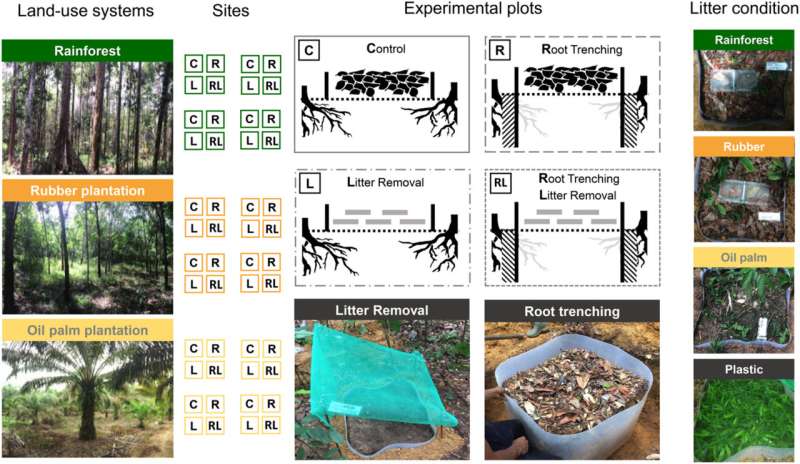Experimental design. Control (C), litter removal (L), root trenching (R) and combined treatment (RL) were established at 12 sites, four in each rainforest, rubber and oil palm plantations in Jambi Province, Sumatra. Credit: Ecology Letters (2023). DOI: 10.1111/ele.14191
Soil animal communities in the tropics are driven by plant roots and the resources derived from them. This is the main finding of a new study of a research team led by the University of Göttingen, the German Centre for Integrative Biodiversity Research (iDiv) and Leipzig University.
Millions of small creatures toiling in a single hectare of soil including earthworms, springtails, mites, insects, and other arthropods are crucial for decomposition and soil health. For a long time, it has been believed that leaf litter is the primary resource for these animals. However, this recent study published in the journal Ecology Letters shows that litter doesn't play any crucial role at all for the tropical soil fauna.
The researchers isolated plots within natural ecosystems and separated the plots from accessing plant roots with a plastic barrier (a technique known as 'root trenching'). Their study included rainforest, as well as both rubber and oil palm plantations in Sumatra, Indonesia. As a comparison, they removed all dead leaves, the main resource of decomposer animals, from other experimental plots. They found that without living roots, animal abundance in the rainforest plots decreases by 42 percent and in plantations by 30 percent.
By contrast, removing the dead leaves has almost no effect on the animals in the underlying soil, but decreased the total animal abundance (in the soil and dead leaves) by 60 percent in rainforest and rubber plantations due to physical litter removal. However, the effects of plant litter removal were not observed in oil palm plantations, where litter is very scarce in any case.
The study also revealed that living roots are especially important for the smaller soil animals, such as mites and springtails. Interestingly, after adding artificial plastic leaves in oil palm plantations, abundance of some animal groups—such as prostigmata—increased, highlighting that improving habitat structure, for instance by mulching, can promote soil food networks and the services they provide.
"The study provides novel perspectives for the management of the resources provided by plant litter in tropical plantations, fostering soil animal biodiversity. This is important to develop sustainable agricultural landscapes in the tropics," says Professor Stefan Scheu, head of the Animal Ecology Working Group at the University of Göttingen.
"This study's findings are significant not only for the conservation of tropical soil biodiversity, but also for the development of global ecosystem models describing carbon cycling in the tropics. We need a better understanding of the complex ecological systems that support life on Earth," adds Dr. Anton Potapov, head of the 'Soil Biodiversity and Functions' research group at the German Centre for Integrative Biodiversity Research (iDiv).
More information: Zheng Zhou et al, Plant roots fuel tropical soil animal communities, Ecology Letters (2023). DOI: 10.1111/ele.14191
Journal information: Ecology Letters
Provided by German Centre for Integrative Biodiversity Research (iDiv)
























